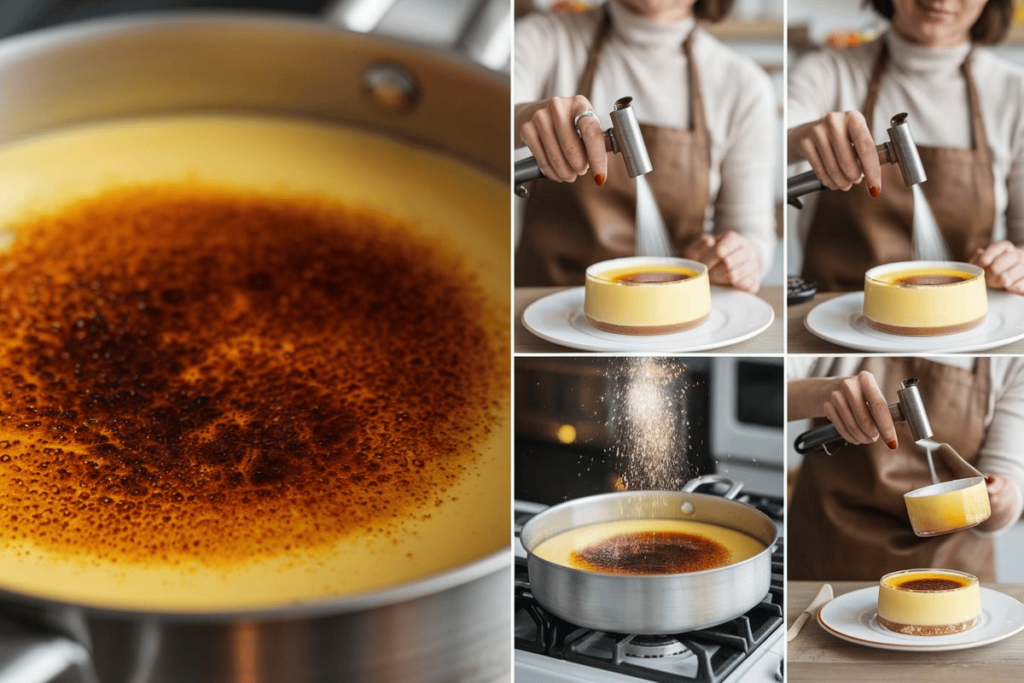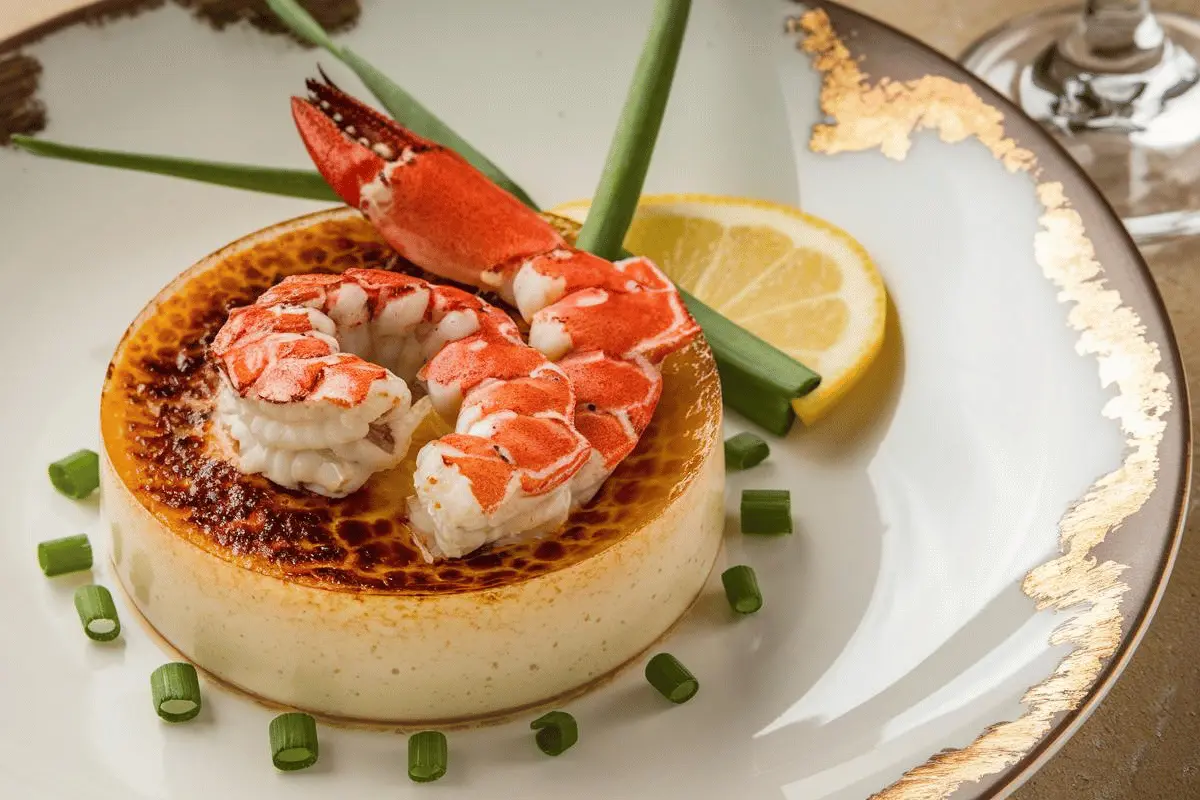Who says crème brûlée has to be sweet? With this Crab Brulee recipe, we’re flipping the script on a classic dessert and turning it into a savory delight that’ll make your taste buds dance. Imagine the rich, creamy texture of traditional crème brûlée, but infused with the sweet, delicate flavor of crab. It’s the kind of dish that’ll have your guests talking long after the meal is over. In this article, we’ll guide you through every step to create a show-stopping Crab Brulee that’s perfect for special occasions or whenever you feel like indulging in something a little extraordinary.
Ingredients for the Crab Brulee Recipe
The magic of this Crab Brulee recipe lies in its ingredients. Each component plays a critical role in bringing out the best in the dish. Let’s take a closer look at what you’ll need:
- 1 lb fresh crab meat: The star of the show, fresh crab meat is essential. Its sweetness and tenderness are what make this dish special.
- 2 cups heavy cream: This gives the brûlée its signature velvety texture.
- 4 egg yolks: Egg yolks are the binding agents, creating that smooth custard we all love.
- 1/2 cup grated Parmesan cheese: Parmesan adds a rich, umami flavor, perfectly complementing the sweetness of the crab.
- 1/4 cup finely chopped chives: Chives provide a subtle oniony flavor that cuts through the richness.
- Salt and white pepper to taste: Seasoning is key to enhancing the natural flavors of the crab without overpowering it.
- 1/4 teaspoon ground cayenne pepper: A touch of heat to add depth.
- 1/4 cup granulated sugar: For that classic, caramelized brûlée topping.
Step-by-Step Guide to the Perfect Crab Brulee
1. Preparing the Crab Meat for the Brulee

Start with the freshest crab meat you can find. Fresh crab is best because its natural sweetness shines through in this recipe. Carefully pick through the crab to remove any bits of shell or cartilage. This is a crucial step – nothing ruins a dish faster than biting into an unexpected crunch. Set the crab aside once it’s clean and ready to go.
2. Crafting the Custard Base
In a medium saucepan, combine the heavy cream and grated Parmesan cheese. Heat the mixture over medium-low heat, stirring occasionally until the cheese has melted into the cream. You don’t want it to boil – just warm it up enough to infuse the cream with that nutty Parmesan flavor.
While the cream is warming, whisk the egg yolks in a separate bowl until they’re smooth and pale yellow. Slowly add a small amount of the warm cream to the yolks, whisking constantly. This step is known as tempering and prevents the eggs from curdling when they’re added to the hot cream. Once the yolks are tempered, slowly whisk them back into the saucepan with the rest of the cream.
Add the finely chopped chives, a pinch of salt, white pepper, and the ground cayenne to the custard. Stir until everything is well combined. At this point, your custard should be rich, smooth, and slightly spicy – the perfect base for your Crab Brulee.
3. Incorporating the Crab Meat
Now that your custard base is ready, it’s time to fold in the star ingredient: the crab meat. Gently mix the crab into the custard, being careful not to break up the meat too much. You want those beautiful chunks of crab to be prominent in the final dish. The goal is to distribute the crab evenly without overmixing, which can make the custard too dense.
4. Baking the Crab Brulee
Preheat your oven to 325°F (160°C). Divide the custard mixture evenly among six ramekins. Place the ramekins in a large baking dish, then carefully pour hot water into the dish until it reaches halfway up the sides of the ramekins. This water bath, or bain-marie, is crucial for cooking the custard gently and evenly.
Bake the Crab Brulee for about 30-35 minutes. You’re looking for a custard that’s set but still slightly jiggly in the center. The top should just begin to turn a light golden brown. Once done, remove the ramekins from the water bath and let them cool to room temperature before transferring them to the refrigerator. Chill for at least two hours to allow the custard to set fully.
5. Creating the Caramelized Sugar Topping
Here comes the fun part! Just before serving, sprinkle a thin layer of granulated sugar over each chilled ramekin. Using a kitchen torch, carefully caramelize the sugar until it forms a golden-brown crust. This crunchy layer is the hallmark of any Crab Brulee recipe and adds a wonderful contrast to the creamy custard beneath.
If you don’t have a kitchen torch, no worries! You can achieve a similar effect by placing the ramekins under a broiler for a few minutes. Just be sure to keep a close eye on them to prevent the sugar from burning.
Serving Suggestions for Your Crab Brulee
Crab Brulee is a versatile dish that can be enjoyed in various settings. Whether you’re serving it as an appetizer, part of a seafood platter, or even as a main course, the following serving suggestions will elevate your presentation:
1. Crab Brulee as an Appetizer
For a refined start to your meal, serve Crab Brulee in smaller ramekins. Accompany it with toasted baguette slices or crisp crackers. The crunch of the bread pairs beautifully with the creamy custard, creating a textural harmony that’s hard to resist.
2. Crab Brulee as Part of a Seafood Platter
If you’re hosting a seafood feast, consider including Crab Brulee alongside oysters, shrimp cocktail, and smoked salmon. The rich, creamy brûlée balances the briny, fresh flavors of other seafood, making it a standout addition to any spread.
3. Crab Brulee with a Fresh Salad
To balance the richness of the Crab Brulee, serve it with a light, citrusy salad. A mix of arugula, fennel, and orange segments dressed in a tangy vinaigrette makes for a refreshing counterpoint to the savory custard.
4. Crab Brulee as a Main Course
Yes, Crab Brulee can be the star of the show! Pair it with a crisp white wine like Chardonnay or Sauvignon Blanc. The acidity in the wine will complement the crab’s sweetness and cleanse your palate between bites, ensuring each mouthful is as delightful as the last.
Variations and Tips for a Perfect Crab Brulee
One of the joys of cooking is experimenting, and this Crab Brulee recipe is no exception. Below are some variations and tips to help you tailor the dish to your taste:
1. Lobster Brulee: A Luxurious Twist
Why not swap out the crab for lobster? Lobster’s sweet, succulent flavor adds an extra layer of indulgence. Simply follow the same steps, substituting lobster meat for crab.
2. Herb-Infused Brulee: Customize Your Flavor
If you’re an herb lover, experiment by infusing the custard with different herbs. Tarragon, thyme, or dill each bring a unique flavor profile that complements the dish’s savory elements.
3. Spicy Crab Brulee: Turn Up the Heat
If you enjoy a bit of spice, consider increasing the amount of cayenne pepper or adding a few drops of hot sauce to the custard. This variation adds a lively kick that balances the dish’s richness with a hint of heat.
4. Crab and Corn Brulee: A Sweet Twist
For a slightly sweeter take, add some fresh corn kernels to the custard mixture. The corn’s natural sweetness pairs wonderfully with the crab, adding a pleasant crunch to each bite.
Tips for Success
- Fresh Crab Meat: Always opt for fresh crab meat if possible. The flavor and texture of fresh crab are unmatched, and they make a huge difference in the final dish.
- Temperature Control: Keep the custard base over low heat when combining the cream and egg yolks. High heat can cause the eggs to curdle, ruining the texture.
- Perfect Caramelization: Use superfine sugar for the brûlée topping. It caramelizes more evenly, giving you that perfect crackly crust with every spoonful.
The Cultural Significance of Crab Brulee
You might be wondering how a dish like Crab Brulee came to be. Traditionally, crème brûlée is a dessert, but its savory cousin is becoming more popular in modern cuisine. This fusion of flavors draws inspiration from various culinary traditions where custards are a staple, albeit in different forms.
In Japan, for instance, there’s chawanmushi, a savory egg custard often flavored with dashi and topped with seafood or vegetables. The concept of savory custards isn’t new; it’s just been given a modern twist in the form of Crab Brulee. This dish exemplifies how versatile crème brûlée can be, moving beyond the sweet and into the savory.
FAQs: Answering Your Crab Brulee Recipe Questions
Can I Use Imitation Crab in this Crab Brulee Recipe?
Technically, yes, but I wouldn’t recommend it. The beauty of this Crab Brulee recipe lies in the delicate, sweet flavor of real crab meat. Imitation crab just doesn’t cut it – it’s often made from fish paste and lacks the nuanced flavor and tender texture that make this dish shine. If fresh crab is out of your budget, you’re better off using a smaller amount of high-quality crab rather than substituting with imitation.
What’s the Best Way to Store Leftover Crab Brulee?
If you’ve got leftovers (lucky you!), Crab Brulee can be stored in the fridge for up to two days. Cover the ramekins tightly with plastic wrap to prevent the custard from absorbing any strong odors. If you haven’t caramelized the sugar yet, you can also freeze the custard. Just be sure to add the sugar topping and brûlée it just before serving for that signature crunch.
Can I Make Crab Brulee Ahead of Time?
Absolutely! You can prepare the custard mixture and bake the brulee up to a day in advance. Store the baked custards in the refrigerator, and when you’re ready to serve, simply sprinkle the sugar on top and caramelize it. This makes it an ideal dish for entertaining – all the hard work is done ahead of time, leaving you free to enjoy your guests.
Is There a Way to Make this Crab Brulee Recipe Lighter?
Sure, but keep in mind that Crab Brulee is meant to be an indulgent dish. If you’re looking to lighten it up, you might try using half-and-half instead of heavy cream. This will reduce the fat content, but it will also result in a less creamy custard. The richness is part of what makes this dish so special, so any attempts to lighten it might compromise the overall experience.
Conclusion
This Crab Brulee recipe is more than just a dish – it’s an experience. It takes the familiar, comforting flavors of crème brûlée and turns them on their head, offering a savory alternative that’s rich, creamy, and utterly luxurious. Whether you’re serving it as an appetizer, part of a seafood spread, or the main attraction, Crab Brulee is sure to impress.
By embracing the creativity and versatility that modern cuisine offers, you can take a classic dessert and transform it into something new and exciting. This Crab Brulee recipe is perfect for those who love to experiment in the kitchen and want to surprise their guests with something truly unique.
So, the next time you’re looking for a dish that’s a little bit different – and a whole lot delicious – give this Crab Brulee recipe a try. It’s a culinary adventure that you won’t soon forget.
